All Dufour Yachts are built in our facility in La Rochelle, France. They all combine fine hand craftsmanship with innovative high-tech construction techniques. It all starts with the hull, and this is how we do it.
It actually all starts in a hull mold. We start with a flawless, highly polished two-piece mold and then spray layers of gelcoat that form the outer layer of each hull. Each hull is then laid up with a precise, highly engineered number of layers of fiberglass, resin, and various core materials that are all placed in each mold by hand.
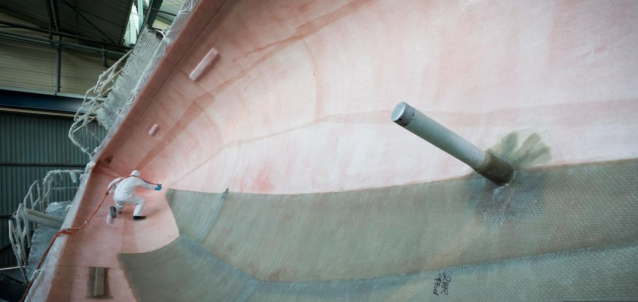
Here you can see the hull is beginning to take shape. Notice the layers of fiberglass and resin that have already been applied. Also notice how the rudder area is reinforced. Our molds are built on special rollers so they can be rotated in-place. This makes it much easier for workers to lay the various layers.
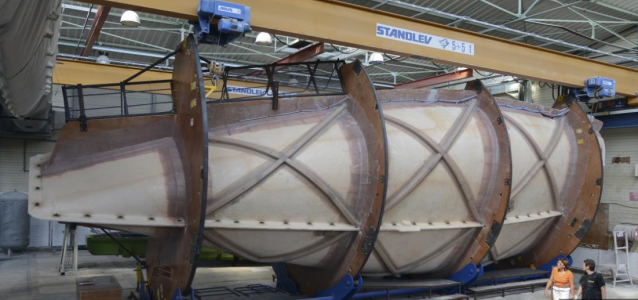
This shot shows the underside of one of our molds. And as you can see, they are extremely well-built to extremely high tolerances so every hull comes out perfect. You can also see how much they can be rotated in place. Rotating molds speed production and increase quality because they are much easier to work on than static molds. All Dufour hulls below 50-feet are built of solid fiberglass while the 500 GL and the 560 GL are laid up with solid fiberglass below the waterline and PVC core above the waterline to provide strength and stiffness. This photo also shows how workers reinforce high-load areas such as chainplate connections and keel areas with increased layers of fiberglass and resin.
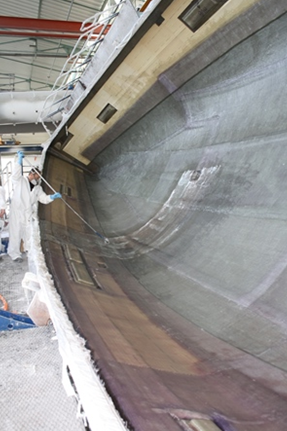
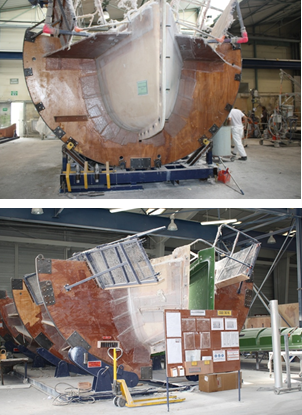
Another important element of hull lamination is the fact that Dufour uses 2-part molds as you can see in the photos above. This makes it easy to release the finished hull from the mold, and it also allows for an inward-facing flange that forms a strong and elegant inward-facing hull-to-deck joint.
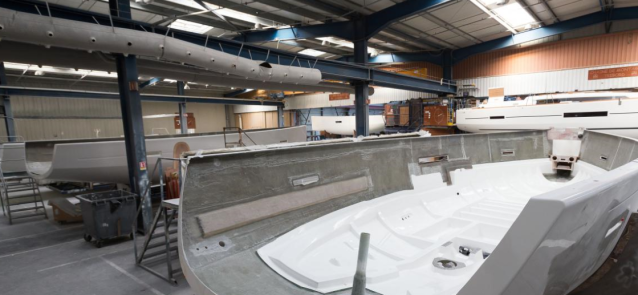
One of the first elements that’s added to freshly laid-up hull is the structural grid. This shot also shows what the inward-facing flange looks like and some of the other early tasks that are done at this stage like cutting out the hull ports and installing a strip of PVC core material to the aft area of the hull to provide increased stiffness.
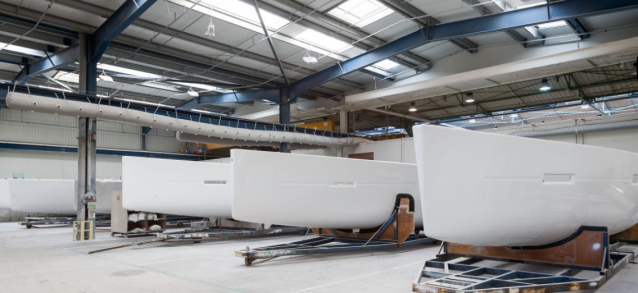
As a result of the high attention to detail paid in the early stages of construction, each hull comes out of the mold looking clean, sexy, and fast.
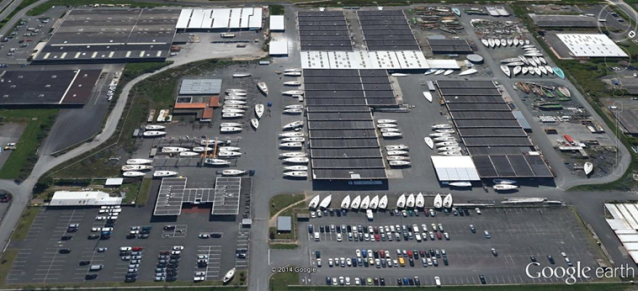
We’re never satisfied with the status quo and our high-tech facility allows us to build the best because every element of the production line is constantly being upgraded. We’re always to looking to improve efficiency and performance, but also you can also see below, we believe our production facility should be as beautiful as our boats.

Both hulls and decks are built of fiberglass in our state-of-the-art facility in La Rochelle, France, but they are actually built in very different ways.
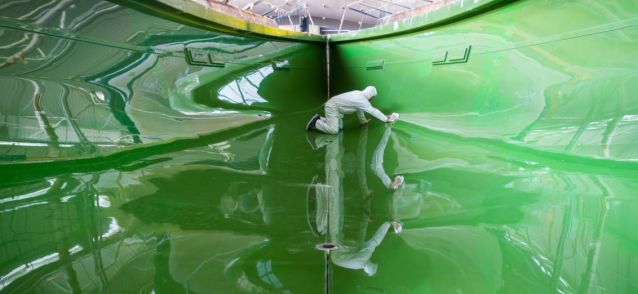
Decks, on the other hand, are “injection molded” in closed, 2-piece molds. This process allows the finished decks to come out of the molds strong and smooth, so smooth in fact that a finished boat won’t need a liner, but, it does require sophisticated engineering and incredible attention to detail during construction.
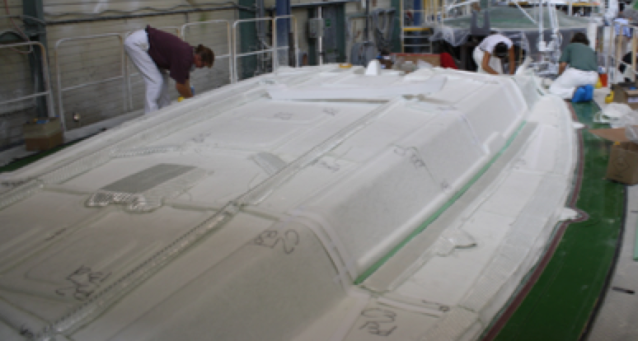
Injection molding requires the entire deck to be laid out with specific layers of fiberglass and reinforcing material in high load areas like winch pads and jib tracks etc to laid up all at once on the “bottom” part of the mold that is first sprayed with gel coat that will form the smooth outer later of the deck.
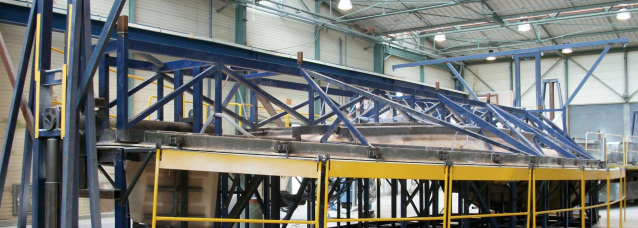
Then the “top” which is also covered with a layer of cured gel coat is lowered on to the bottom part that’s laid out with the required sandwich material. The two parts are then joined and form an air tight seal and then the magic happens.
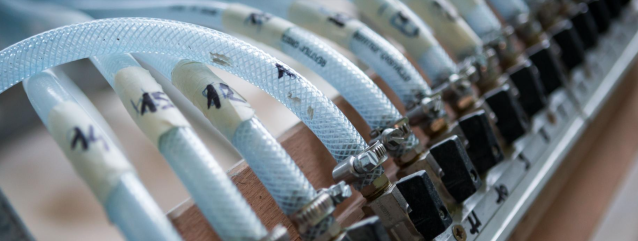
It’s not actually “magic” but, once the two parts of the mold are sealed, workers can then start “injecting” the resin into the mold. The resin is pumped in through hoses and the seal insures complete resin saturation. This is ideal because it results in a strong deck without requiring excess resin.
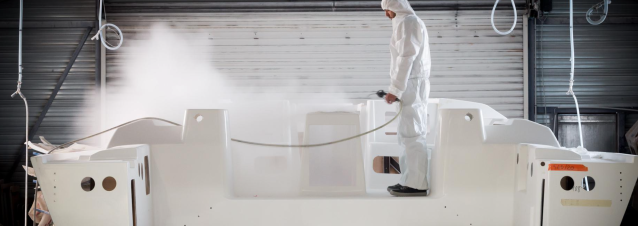
Injection molded decks are virtually flawless (on both sides) when they come out of the mold.
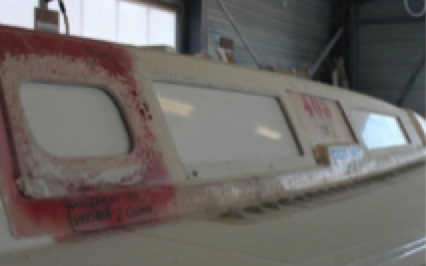
Then workers use jigs to cut out the areas for ports and hatches as well as drill all necessary holes to install all the deck hardware.
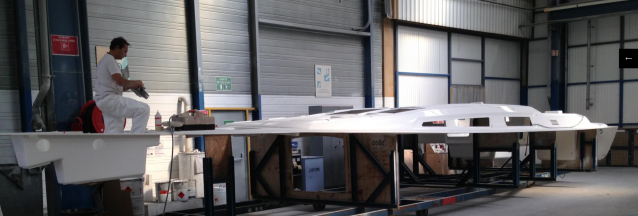
Then the deck hardware is attached before the deck is the lowered on to the hull.
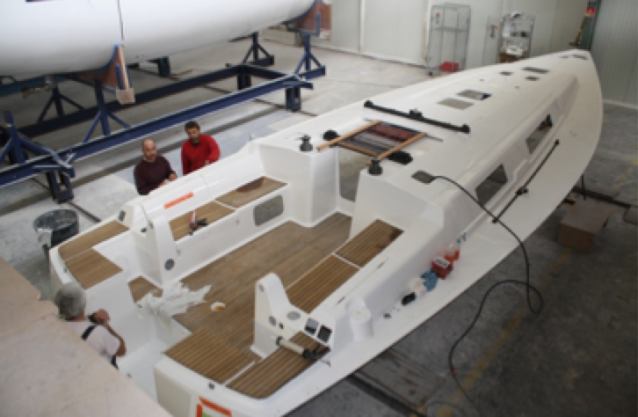
And the best part is, the underside of the deck is beautiful. This allows for increased headroom (since no deck liner is needed) and the sleek, modern look Dufour Yachts are known for.
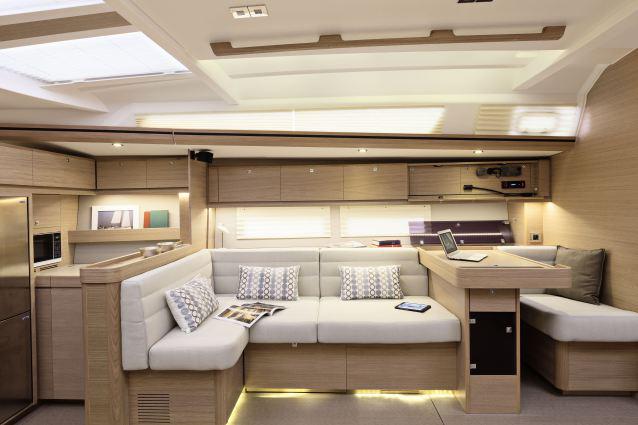
How an empty shell of a hull that first comes out of a mold becomes a Dufour Yacht?
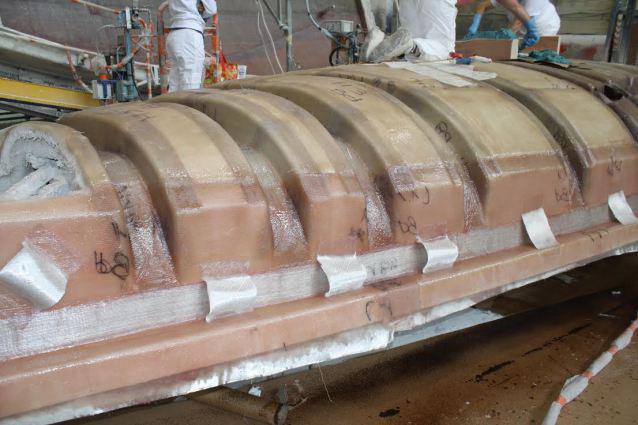
It all starts with solid fiberglass structural grid (above) that’s engineered to provide strength as well as provide solid connection points for all the interior components.
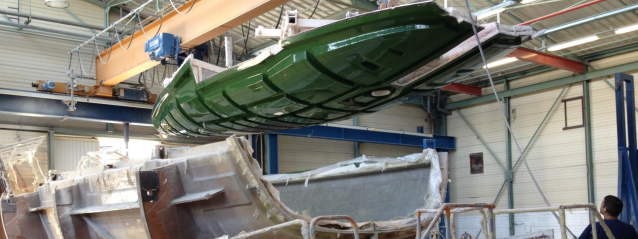
Dufour’s grids are built the same way the hulls are. Specific layers of fiberglass, resin, and gelcoat are laid up on a mold. As you can see in the photo below, the one-piece grid that comes out of the mold has a highly finished gelcoat surface. This allows the grid to be as attractive as it is strong and allow for wonderfully clean locker and cabinet floors, as well as sump areas.
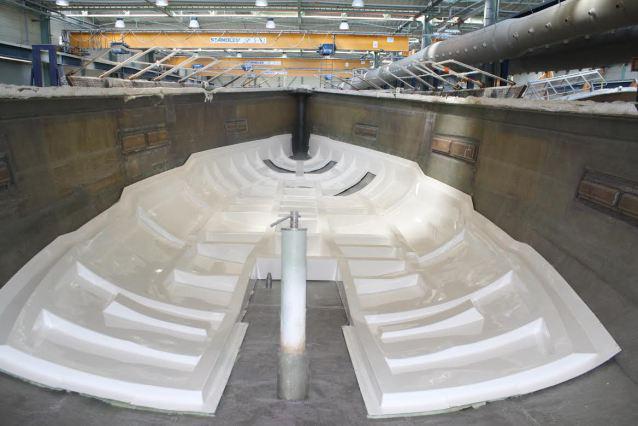
Attaching the grid is literally the first step in the assembly process. It’s actually chemically fused to the hull with adhesive.
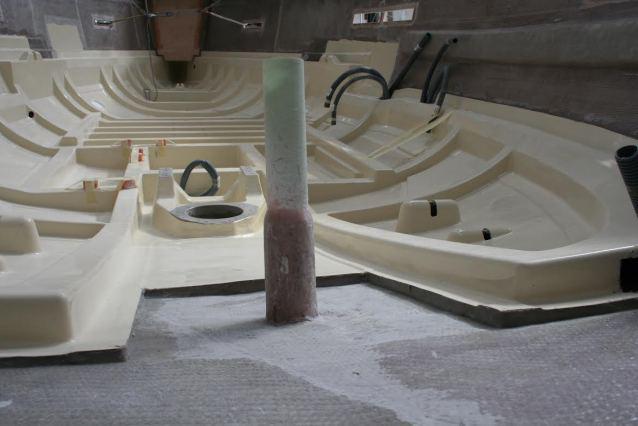
The support beams are molded into the grid and the entire structure is fused to the hull. Notice the circular hole and solid mounts that are designed for the engine and saildrive and the black hoses that are there to make it easy to run plumbing and wiring.
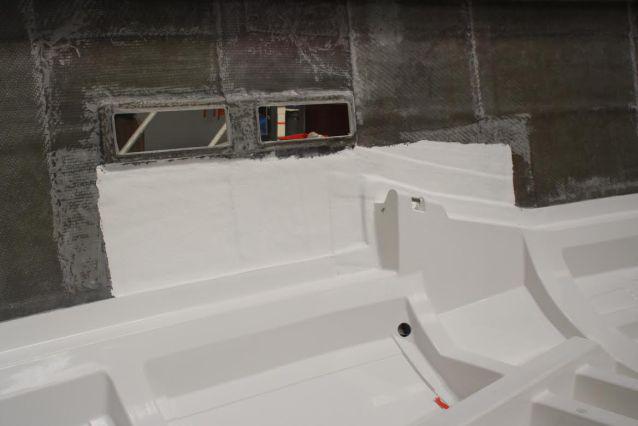
The grid is also tabbed in place with fiberglass in high load areas around the chainplate anchors (pictured above). This spreads the load of the rig out over a wide, heavily reinforced area.
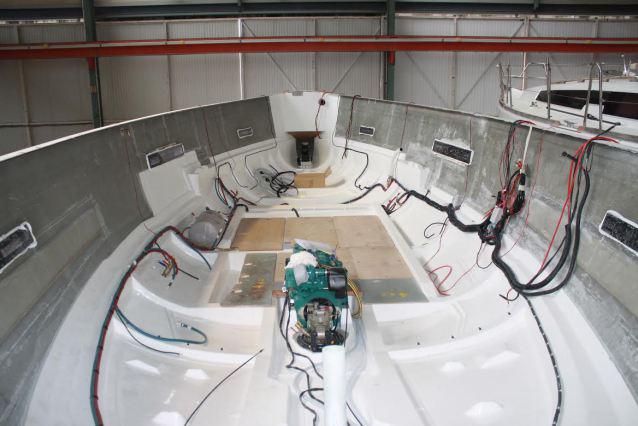
Once the grid is in place, the boat quickly starts to take shape. Here you can see the engine and saildrive have been installed. Some wiring and plumbing have been run. Hull ports have been installed. The first of several tanks have been dropped into place, and even the anchor locker is taking shape. Notice also the temporary plywood “floorboards” in front of the engine. Those are there to make it easy for workers to move around and will be replaced with the much more stylish ones as the boat moves down the production line.
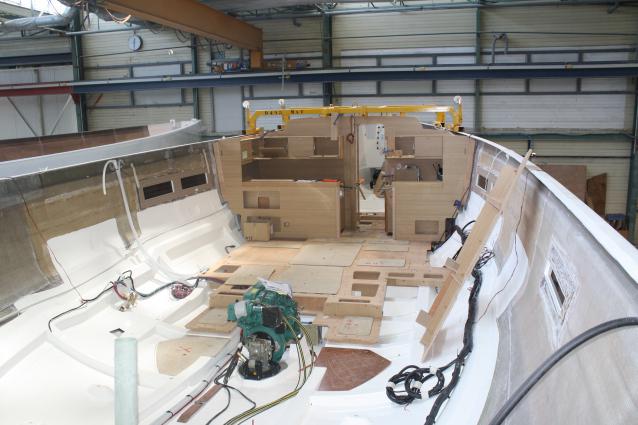
Construction quality is the foundation of what makes a Dufour a Dufour and we take great pride in the way our hulls and decks are built and strengthened. Strict attention to detail and sophisticated engineering is just one of the many things that make Dufour Yachts such solid performers. But the truth is, lots of the quality you get in a Dufour goes on underneath the floorboards and behind furniture. So, like the foundation of your house, the benefit from these essential functions often go unseen.
So the next installment of this popular series is going to show how all Dufour Yachts start to take shape beneath the surface during construction. And as you can see in the photo above, bulkheads are some of the first elements to be added as the open hull makes its way down the production line. The yellow metal frame pictured above holds the bulkhead in place to ensure a precise fit.
Here in this close-up shot you can see bulkheads are tabbed to the hull with a wide layer of fiberglass and resin to form a ultra-strong bond and are closely inspected to ensure structural integrity.
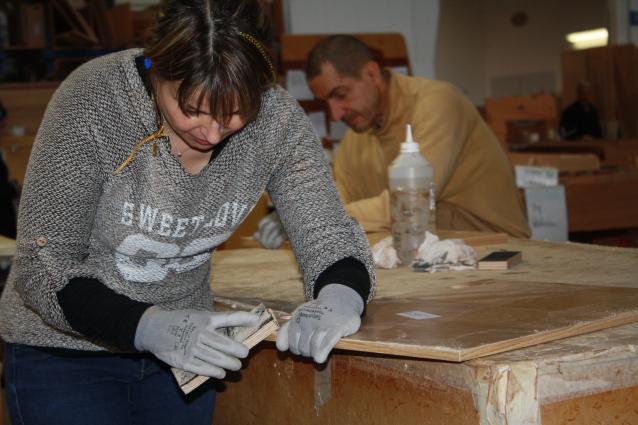
An incredible amount of hand craftsmanship goes into every Dufour Yacht. But we also use highly efficient CNC machines to cut wood panels very quickly and precisely to help speed production along as well.
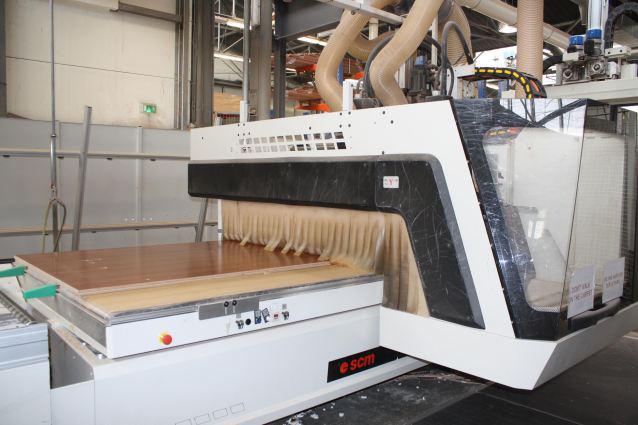
Modular construction–i.e. the interior gets built in sections (modules) and then installed in the hull as it moves down the production line. This makes it possible to improve both the quality and the speed of production.
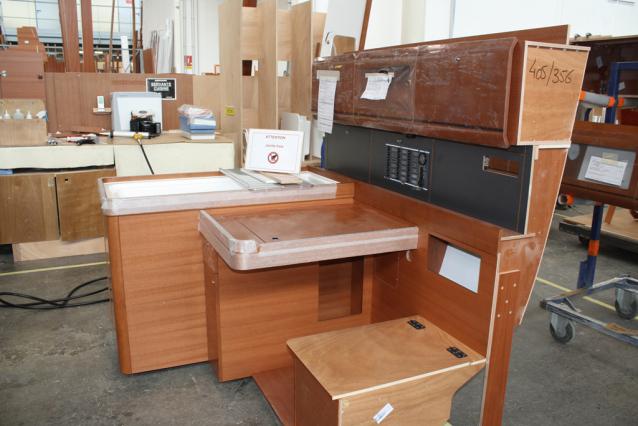
Here’s a completed nav station (including the electric panel and the highly insulated refrigerator box) that’s been built in the woodshop and waiting to be placed into the appropriate hull that’s moving down the production line.
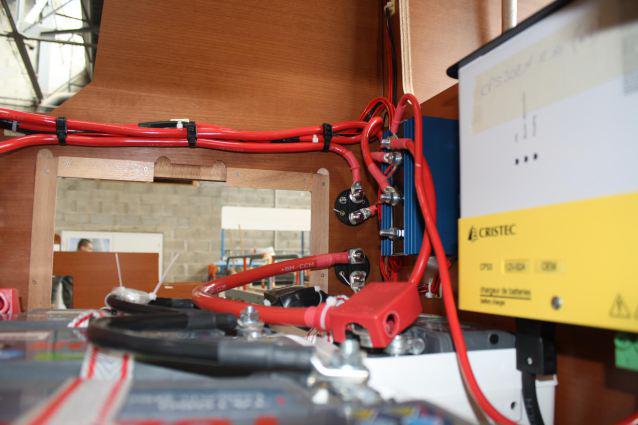
Modules can also be pre-wired with all the necessary wiring and electronics and then highly skilled electricians make sure all the connections are complete once the module has been placed into the hull.
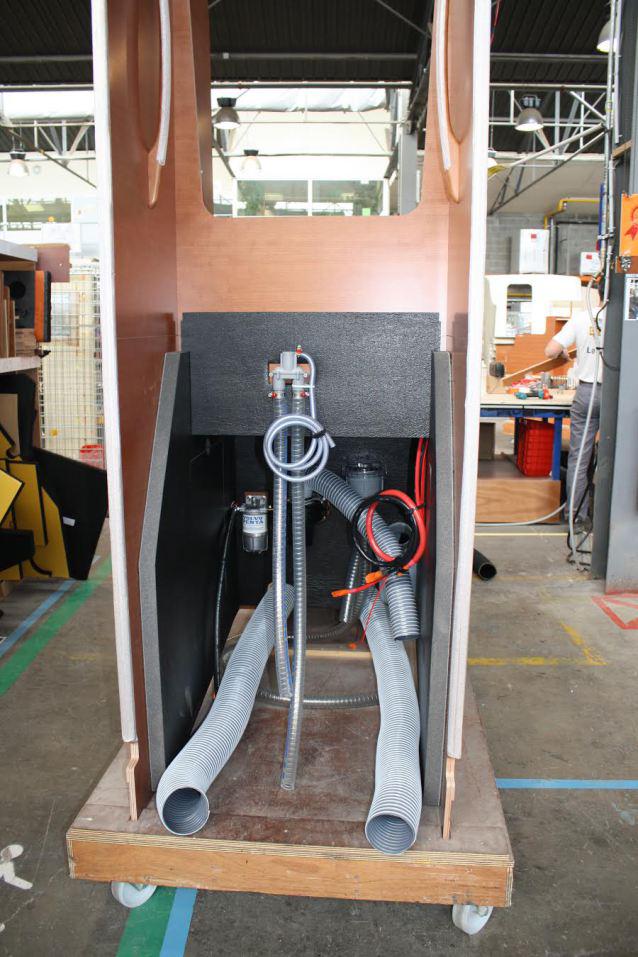
As you can see above, air conditioning ductwork, vented loops, soundproofing, and even the engine’s fuel filter can be pre-installed.
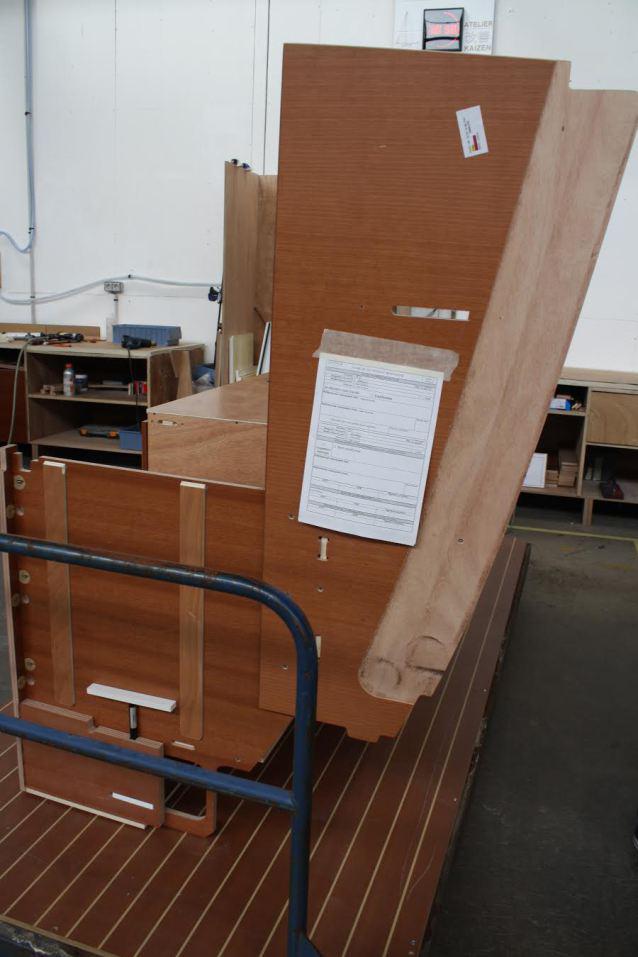
This module also includes a section of bulkhead that must be bonded with the hull. The area that will be joined with the hull is prepared to insure there is a solid mounting surface that’s receptive to resin for the tabbing material.
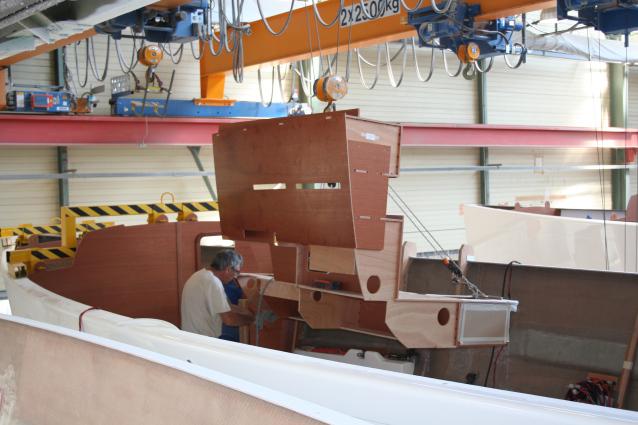
Completed modules then get lowered into place in the hull. Workers use remote-controlled hoists in the factory that allow easy handling and placement of the module sections/ The piece is then bonded in place with adhesive, fiberglass tabbing, and other mechanical fasteners.
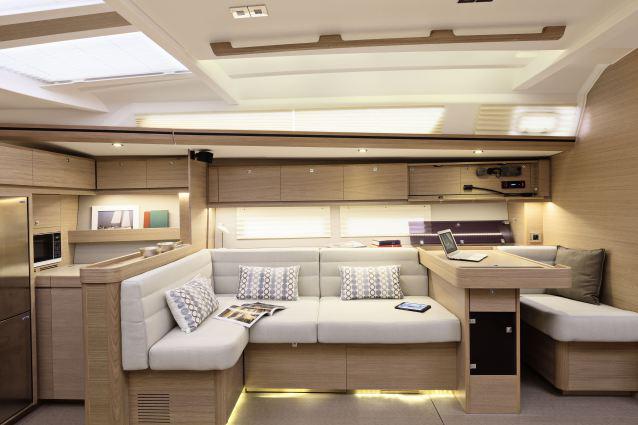
We’re not at the finished boat yet. But we’re getting there.
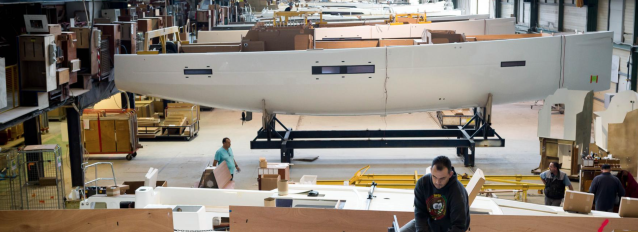
The nearly completed boats continue their steady march toward the trucks at the end of the line that are waiting to take them to destinations all over the world.
The furniture modules have all been lowered into place. The wiring and plumbing has been run. Bulkheads have been tabbed in place. Fixtures are installed. And the boat is really starting to look like what you’ll see on the water in a couple weeks.
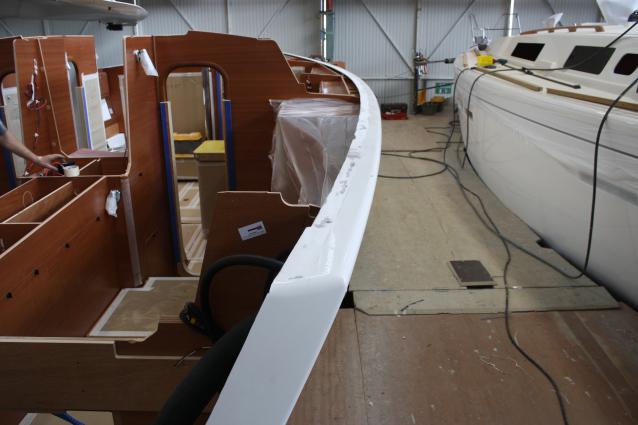
So last big event, lowering the deck down onto the inward-facing flange of the hull-to-deck-joint–is all that’s left to do. And as you’d expect, this critical step is not taken lightly.
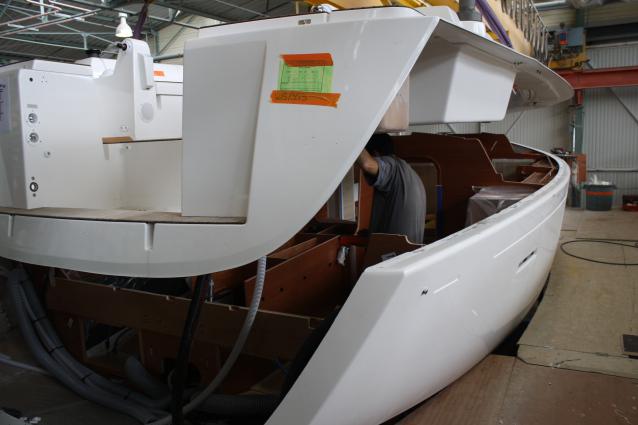
Everything on the completed deck is checked and double checked before the hull is bonded with the deck with both chemical adhesive and mechanical fasteners to form an incredibly strong seal.
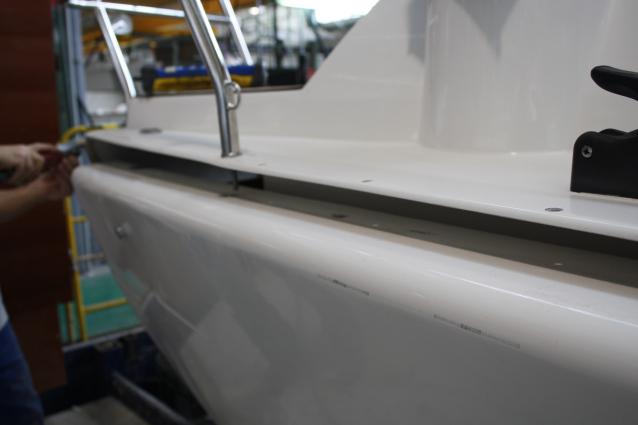
The deck is also pre-drilled with counter-sunk holes to accept the screws that are used to both reinforce the joint, and secure the stylish teak toe rail.
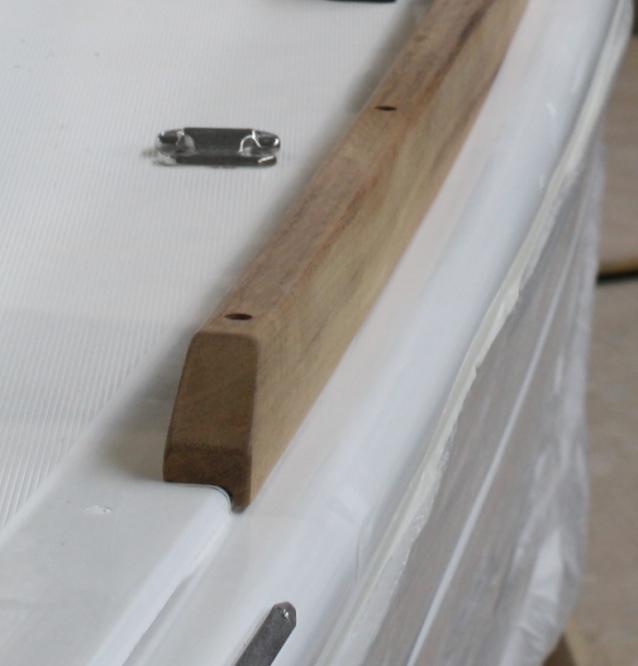
In the end, every yacht leaves the factory with a beautiful curved edged joint that’s both strong and stylish.
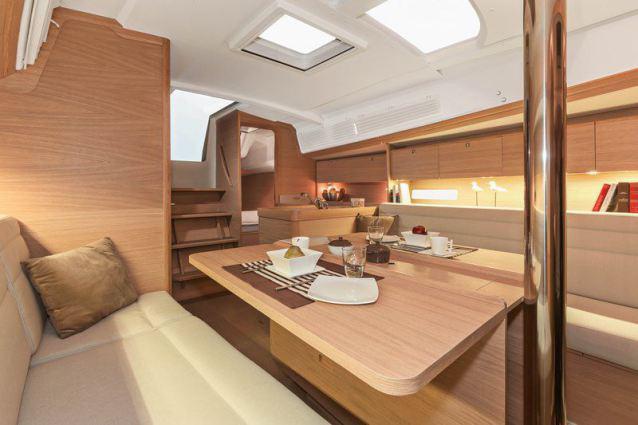
Meanwhile, teams of workers go through the interiors of each boat to ensure that every detail of the boat is finished to extremely high standards.
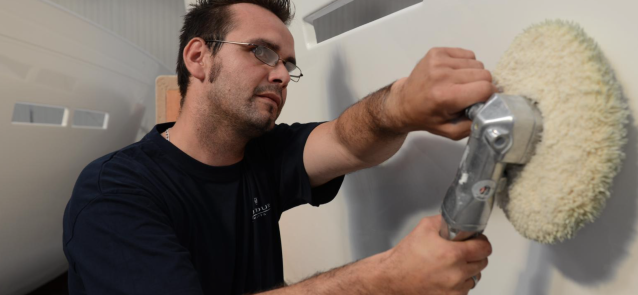
And no boat proceeds off the line until it passes a strict regimen of quality control tests including….
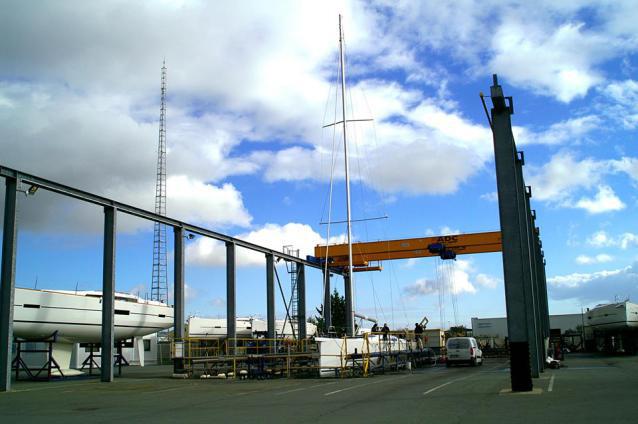
…making sure each boat is completely watertight, and that the engine functions properly in Dufour’s special test pool at the end of the line.
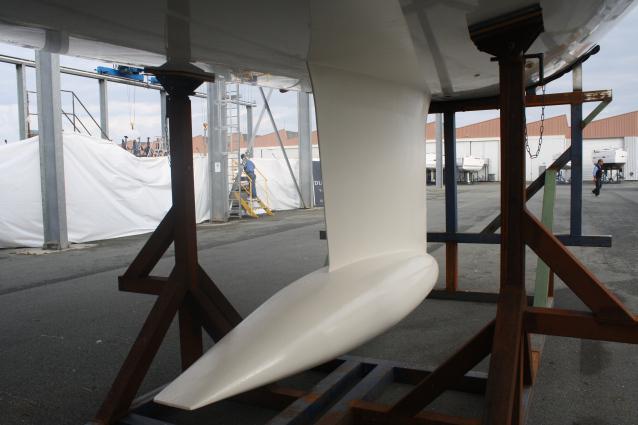
After passing all quality control tests (both inside and outside) each Dufour is then prepped for transportation to happy owners all over the world on these custom-built cradles. The cradles are designed to work on trucks and also on container ships and to make sure the boats make it to their destinations in the bristol condition they leave the factory in.
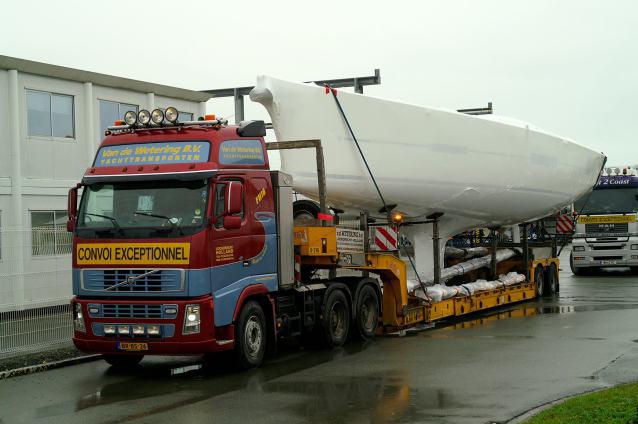
The hulls get shrink wrapped. The rigs get protected too. And then the real fun begins.
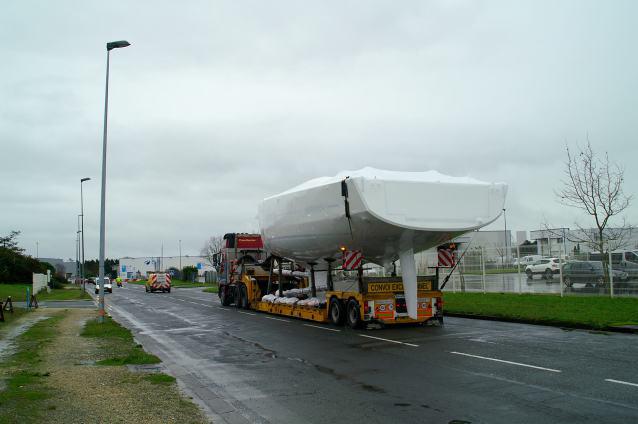
The 560 is so big it needs an escort on the roads. But needless to say, it’s more than self-sufficient on the water.
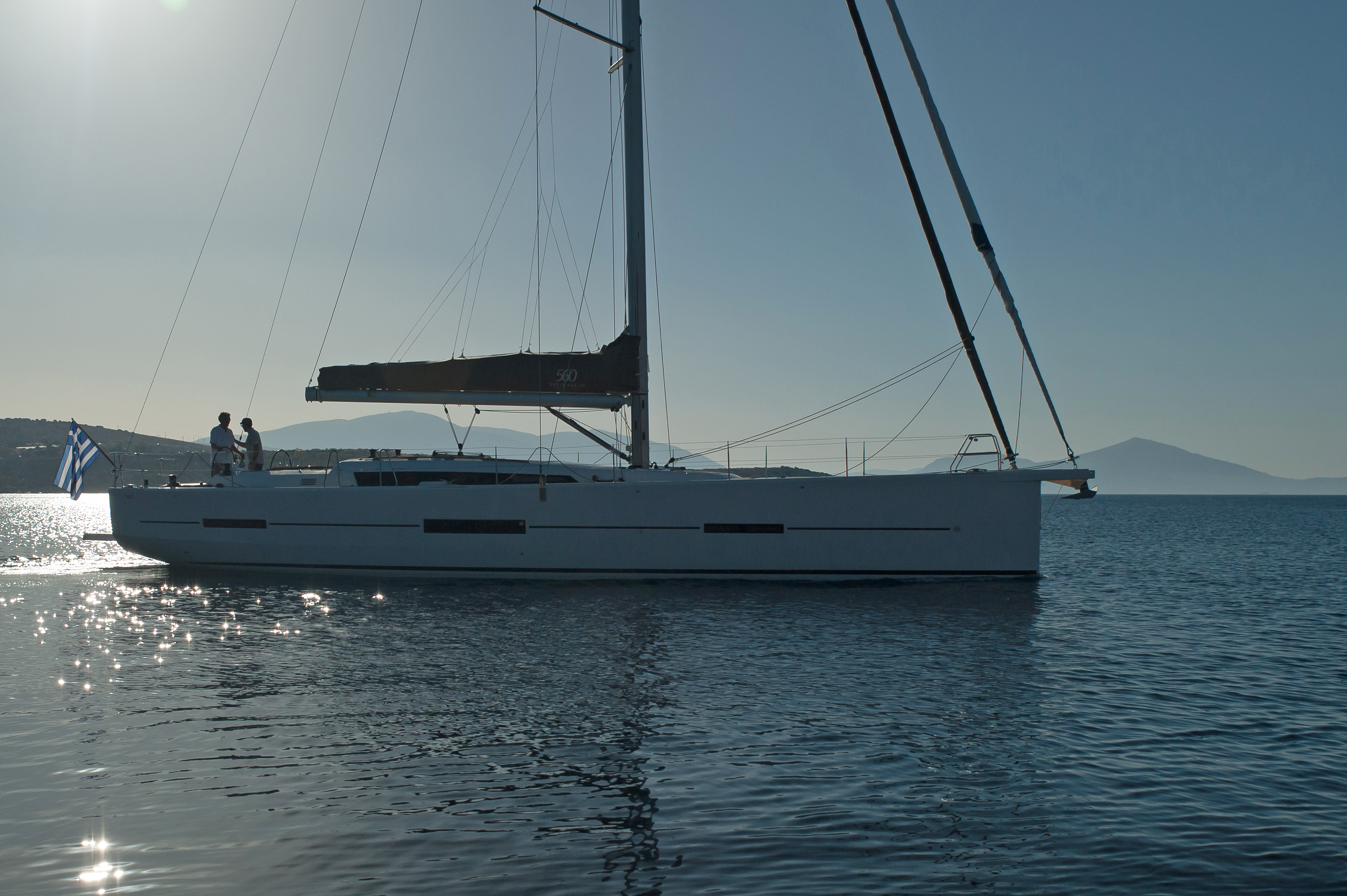
If you’re in the market for a new yacht and want to see the process firsthand, please let us know. We’d love to arrange a tour so you can see how we live 50 years of yachting passion every single day.